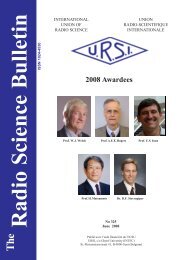Radio Science Bulletin 313 - June 2005 - URSI
Radio Science Bulletin 313 - June 2005 - URSI
Radio Science Bulletin 313 - June 2005 - URSI
- No tags were found...
You also want an ePaper? Increase the reach of your titles
YUMPU automatically turns print PDFs into web optimized ePapers that Google loves.
-10-20MPMSS1SS2-30-40RMSE [dB]-50-60-70-80Figure 14. Closed finite conducting cylindermodel with an aspect ratio of L/d = 5.Figures 12 and 13 plot the extracted complex resonantpoles for NSIG = 10 and 14. The extracted poles areidentical for each method, which means that the singularvalues are equal, even though the starting Hankel matrix foreach method is different. Again, the three DDD methodsperform equally well.5.3 Finite Closed ConductingCylinderFor the third example, consider a finite closed cylinder(Figure 14). The length and diameter of the cylinder are 1m and 0.2 m, respectively, so that the aspect ratio (length/diameter) is 5. The angle of the θ -polarized incident fieldis 45° from the axis of the cylinder (z axis). In this example,the parameters for the Gaussian window that is applied tolimit the bandwidth of the frequency domain result (10-1500 GHz) are σ = 0.15 and ct 0 = 8.5 . After windowing,the back-scattered field is reconstructed from the inverseFourier transform (Figure 15). The return is negligible after55 ns.Backward Scattered Field10.80.60.40.20-0.2-0.4-0.6-0.80 10 20 30 40 50 60 70 80Time [nsec]Figure 15. Back-scattered field in the time domainfor a finite closed conducting cylinder.-902 4 6 8 10 12 14NSIGFigure 16. RMSEs in the reconstructed signal for finiteclosed conducting cylinder.Pole extractions and approximations with the threemethods are done with this time-domain signal of Figure15. For each method, the RMSEs are the same and thethreshold is satisfied with 15 damped sinusoids (Figure 16).jωL /cπ109876543210-1 -0.9 -0.8 -0.7 -0.6 -0.5 -0.4 -0.3 -0.2 -0.1 0α L /cπFigure 17. Extracted poles for NSIG = 15 for a finiteclosed cylinder. The x-axis and y-axis represent the realand the imaginary values of the pole, normalized withrespect to the length L of the cylinder, and c is thespeed of light in free space.Also, the locations of the extracted poles are nearly identical(Figure 17). However, the elapsed CPU times are verydifferent from those of the preceding examples. In particular,the average CPU times for the MPM, the SS1, and the SS2are 19.1 s, 24.7 s, and 391.5 s. The time for the MPM is about71% of that for SS1 and 4.87% of that for the SS1. Similarto the preceding example, the MPM is at least 25% fasterthan the State-Space Methods.5.4 Dielectric SphereMPMSS1SS2The fourth example is a dielectric sphere with ε r = 4and a 0.5-m radius, and the incident field is coming from thetop of the sphere along the z-axis and is x-polarized. Theback-scattered field has been obtained using WIPL-D in thefrequency range of 10-1500 MHz. The parameters of theThe<strong>Radio</strong> <strong>Science</strong> <strong>Bulletin</strong> No <strong>313</strong> (<strong>June</strong>, <strong>2005</strong>) 35
















